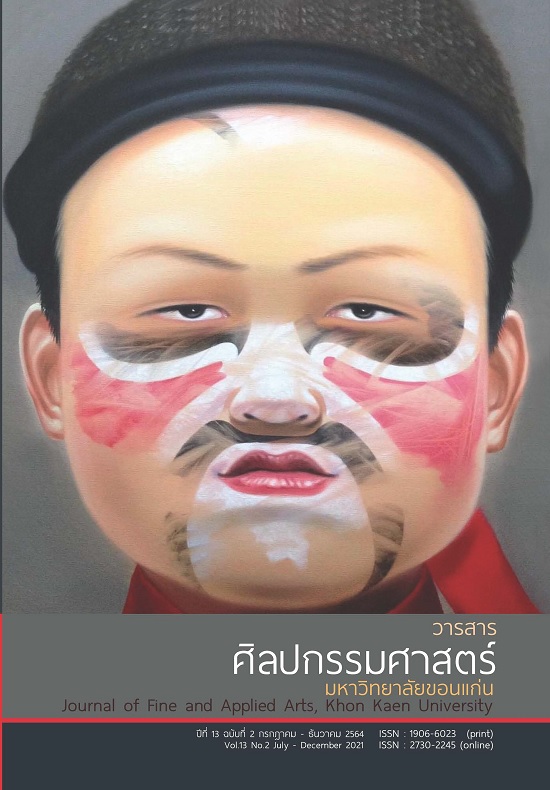Sound Creation in Khong Wong Yai Solo of Praya Sanoh Duriyang (Cham Sundaravadin)
Main Article Content
Abstract
This article is partial writing of a dissertation entitled ‘Splendid song selection and sound creation of Praya Sanoh Duriyang (Cham Sundaravadin)’. The purpose of this study was: to analyze crucial Khong Wong Yai solo pieces of which Praya Sanoh Duriyang had composed and have been inherited until present days namely Phaya Soke sam chan, Keakmon sam chan, Cherd Nork, and Grouw Nai sam chan. The study was a musical analyzing method particularly using Thai musical systematic approach. The paper is therefore descriptive writing to examine an idealistic construction on a Khong Wong Yai instrument of solo playing. The findings indicated that 1) the solo pieces were composed basing strictly on musical structures and principles of traditional viewpoints and perhaps occasionally using the flexibility of melodic and rhythmic contexts of song styles. 2) Arrangement of melodic equilibration on emphasizing defying-defending musical phases and special techniques. In addition, the sound creation process took up a clearness of Khong Wong Yai sound making and appropriation of physical playing between the techniques and melodic movements. This study tends to present a process of sound creation attentively focus on both melodic phrase units and entire songs. As well as, to maintain the original styles of musical tradition by schooling transmission through merely face-to-face learning methods. The process thus implicates the valuable importance of traditional practices-called oral tradition that is the dominant way of Thai music transmission in terms of preserving idealistic thought of music school in established practices.
Article Details
Content and information in articles published in the Journal of Fine and Applied Arts of Khon Kaen University is regarded as the opinion and sole responsibility of the author(s) directly; therefore, editors are not obliged to agree to or share any responsibility with regard to the content and information that appears within these articles.
All articles, information, content, image, etc. that have been published in the Journal of Fine and Applied Arts of Khon Kaen University is the copyright of the Journal of Fine and Appllied Arts of Khon Kaen University. Any person or organization who wishes to distribute all or parts of the articles for further dissemination or other usage must first receive permission from the Journal of Fine and Applied Arts of Khon Kaen University before proceeding to do so.
References
เจตนา นาควัชระ. (2560). ข้อคิดเบื้องต้นกับบทบาทของทฤษฎีในกระบวนการวิจัยทางมนุษยศาสตร์. ใน รื่นฤทัย สัจจพันธุ์ (บรรณาธิการ). ทฤษฎีกับการวิจารณ์ศิลปะ: ทัศนะของนักวิชาการไทย. (หน้า 20-48). ปทุมธานี : นาคร.
ถาวร สิกขโกศล และศิริ วิชเวช. (2543). เสภา เสนาะคำหวาน. กรุงเทพฯ : ศูนย์มานุษยวิทยาสิรินธร.
ปาณิสรา เผือกแห้ว. (2548). เดี่ยวปี่ในเชิดนอก: ทางครูปิ๊บ คงลายทอง. วิทยานิพนธ์ปริญญาศิลปะศาสตร
มหาบัณฑิต สาขาดุริยางค์ไทย คณะศิลปกรรมศาสตร์ จุฬาลงกรณ์มหาวิทยาลัย.
พิชิต ชัยเสรี. (2559). สังคีตลักษณ์วิเคราะห์. กรุงเทพฯ : สำนักพิมพ์แห่งจุฬาลงกรณ์มหาวิทยาลัย.
พิชิต ชัยเสรี. (2560, 6 เมษายน 2560). สัมภาษณ์. ข้าราชการบำนาญ, รองศาสตราจารย์, จุฬาลงกรณ์มหาวิทยาลัย.
พูนพิศ อมาตยกุล และคณะ. (2532). นามานุกรมศิลปินเพลงไทยในรอบ 200 ปี แห่งกรุงรัตนโกสินทร์. กรุงเทพฯ : จุฬาลงกรณ์มหาวิทยาลัย.
พูนพิศ อมาตยกุล. (2540). ลำนำแห่งสยาม. กรุงเทพฯ : ไฮไฟ สเตอริโอ.
พูนสุข กุหลาบวงษ์. (2545). การวิเคราะห์เพลงมอญคละ: กรณีศึกษาสำนักพระยาเสนาะดุริยางค์ (แช่ม สุนทรวาทิน). วิทยานิพนธ์ปริญญาศิลปศาสตรมหาบัณฑิต สาขาดนตรี บัณฑิตวิทยาลัย มหาวิทยาลัยมหิดล.
มานพ วิสุทธิแพทย์. (2556). ทฤษฎีการวิเคราะห์เพลงไทย. กรุงเทพฯ : สันติศิริการพิมพ์.
วิรัช สงเคราะห์. (2555). รูปแบบการขับเสภาทางพระยาเสนาะดุริยางค์ (แช่ม สุนทรวาทิน). วิทยานิพนธ์ปริญญาศิลปศาสตรมหาบัณฑิต สาขาไทยคดีศึกษา บัณฑิตวิทยาลัย มหาวิทยาลัยสุโขทัยธรรมาธิราช.
ศรีนิวาสัน, จี. (2534). สุนทรียศาสตร์: ปัญหาและทฤษฎีว่าด้วยความงามและศิลปะ. (สุเชาวน์ พลอยชุม, ผู้แปล). พิมพ์ครั้งที่ 2. กรุงเทพฯ : โรงพิมพ์มหามงกุฎราชวิทยาลัย.
สุพจน์ จิตสุทธิญาณ. (2556). ความเข้าใจในทฤษฎีสุนทรียะ. วารสารศิลปศาสตร์ มหาวิทยาลัยอุบลราชธานี, 9(2), 161-179.


